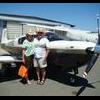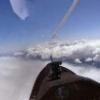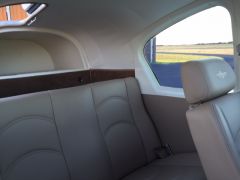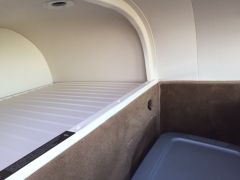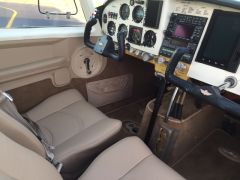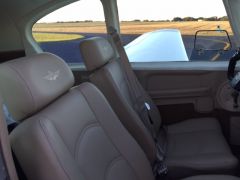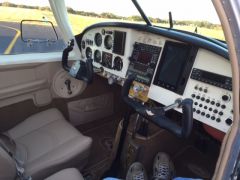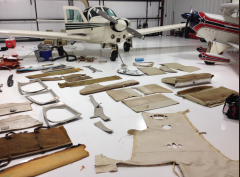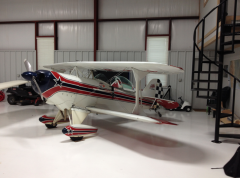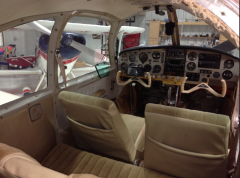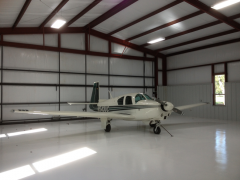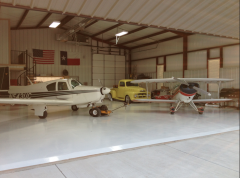Leaderboard
Popular Content
Showing content with the highest reputation on 01/04/2018 in all areas
-
Passed my IR check ride on my last flight of 2017...woohoo!!! Now on to CPL And testing for my A&P And MEL Ron5 points
-
Forgetting about the new technical skills developed as a result of working on the instrument rating, there's a whole other area of expertise that is developed during the course of the training, and that is the learning the whole ATC system and how it works. When I was a Private Pilot, I really didn't get the whole perspective of our System and how to best utilized it to accomplish what I wanted. Working on the instrument rating opened up new vistas of understanding on how to work the System. That benefit should not be underestimated.4 points
-
Without even talking about IFR vs. VFR, I'm still waiting for someone to explain how flying 20-40 hours with an instructor, learning a new skill, and taking a checkride would not make them a better pilot (unless you're Chuck Yeager, of course).4 points
-
I will not take that one on. I began flying in 1972. Single and Multi Engine rated Private Pilot. 10 years ago I got my instrument rating. I still fly VFR mainly, have been IFR twice. The instrument rating was the best training I ever got in my Mooney. I did many circle to land approach's, you will learn how to be on speed in a challenging approach. I have a safety back up if I get caught and need to go on instruments. You must practice and practice more. I usually will do an IPC once a year after practice approach's all year. Having learned to fly in 1972, I did not us ATC services very much, I am much more proficient now at using ATC services, even when VFR. In all of the years before getting my instrument, I did do recurrent hood work just in case. I have and will cancel trips due to weather. Many times I will end up driving a long trip (1700 miles), only to see great VFR weather starting 200 miles away from home. Please get the training, it is well worth it. The life you might save, could be yours, the wife, kids or grand kids. Ron3 points
-
2 cents coming, read on at you're own risk. As a newly rated IR pilot (12/28/2017) I will say that the IR training has made "me" a better pilot, that's what training is for, right? The rating only gives me the ability to use the training to continue learning. (making "me" a better pilot is not a setting of a very high bar as I'm pretty new to this whole flying thing) I have posted my reason for pursuing the training previously on this site. I was kinda like the guy we talked about who started this thread, but it was a local flight and I had plenty of outs, which I ended up using one of. The key for me was that my daughter was with me and as we were aimed at a runway that we couldn't see I could see the uncertainty and un-comfortableness in her. We tried twice to make an approach to a fogged in field that we could see clearly from above but it would disappear when lined up on final from either direction. It was a severe clear night with freak fog. We diverted to another field and landed fine. I made the decision right then to pursue the IR training and then once I had the training I decided to get the rating. YMMV! Ron3 points
-
When I was looking to replace my OEM clock I wanted one with two time displays. I couldn’t find one and I thought I was being too picky, it’s just a clock after all. Or is it?! But I called Kevin at Davtron and he recommended their M802. I couldn’t be happier! I really like it because it has the two time displays. It permanently displays zulu as well as local time along with the usual timer functions. Davtron makes excellent products. I also have the M655 primarily for an instantaneous display of DA. It has a few other functions incl. OAT.3 points
-
I haven't read anyone's post that inferred VFR pilots are not as good as IFR rated pilots. I have read repetitively where it will make you a better pilot. Heck, I know some IFR rated pilots I wouldn't let my ex wife fly with. What seems common is that everyone that has the IFR rating thinks it is worth it in both terms of added competency and capabilities, and those that do not tend to justify not getting it with both valid and invalid reasons. If you can afford it, and afford the plane to be capable of IFR flight, it is well worth it in terms of additional utility, an added way to stay tuned up to flight, increase your capabilities, and to get another merit badge There isn't anything wrong with VFR only pilots or flying, nor are they an inferior class. By regulation and by the basic need of survival, a VFR pilot is more restricted.3 points
-
As I understand, zero fuel weight refers to certain aircraft (think larger wing spans) that must have a significant portion of the useful load as fuel. Weight in the form of passengers & cargo, even if they are well below MGTW, place excessive stress on the wing in turbulent conditions. Said another way, an example aircraft may have a useful load of 1000 pounds, but 400 pounds MUST be as fuel in order for the aircraft to be safely loaded. Meaning only 600 pounds may be people & stuff. Go over that number and you exceed the zero fuel weight. IF an aircraft has a zero fuel weight requirement, it will be listed in the POH for that aircraft. PP studying for CFI3 points
-
If you want it, buy a good plane and fly it whenever. Add up the total airplane costs after adding up your total car ownership costs, and don't forget to include a square footage allocation for the garage at home (if you have one). Just pay the bills as soon as they come due! I've been flying my Mooney in blissful ignorance for over ten years now, and I'm still not bankrupt . . . .3 points
-
Thank God we have this exact, same argument every 12-15 months. I might grow to miss it if we didn't. Sigh.2 points
-
2 points
-
It makes YOU a better pilot that what YOU currently are, not compared to anyone else.2 points
-
After further consideration, I've decided to wear this timepiece in the cockpit going forward. The size makes it easily readable, and it has a second hand. The FARs say nothing about the clock having to meet the FAA Administrator's sense of personal style. And I'll know to expect IFR release when parachute pants return to popularity2 points
-
Aircraft partnerships are almost like a marriage. You definitely need to find the right partner or it'll cost you big-time!2 points
-
2 points
-
I was asking this same question about four years ago. I had the funds to buy an airplane, but really wondered if I'd use it, or even have time to use it. Or if it would be like so many boat owners who only use it on Memorial and Labor Days and the rest of the time it sits. So I went the conservative route and bought a '64 M20C. Because I was way under my budget, I could afford to get the nicest one I could find and was still under budget. Two years and 400 hours later, the wife and I KNEW that we knew how to make use of an airplane. So we sold the C and moved up to an M20K 252. We've used the Mooney in ways we never imagined prior to being airplane owners.2 points
-
I got a very pleasant follow-up call from the Memphis FSDO while I was walking in to work this morning. The gentleman told me what information he had regarding the incident, and essentially asked me to fill in the details on the event and subsequent maintenance performed to remedy the problem. Took about three minutes, with shared well wishes for the new year. No paperwork requested on this one. Cheers, Rick2 points
-
Or just slow down. No reason to be burning it up on an approach or during a high workload time - make your mooney fly at 182 speeds and you have more time to do everything.2 points
-
Moreover it difficult to find one who would put in the funds and more importantly the effort to fly to near professional standards, meaning flying with the utmost care and respect necessary to be a competent safe pilot for decades. The chances I had to add a partner would cause loss of sleep along with me wondering when I turn the key will all be right. It's hard to put in words without offending people picking a partner similar to getting married,there's lots of divorces out there. It's a lot more than feeding a hungry Bravo2 points
-
2 points
-
I would rather see the women than hear the virtues of a Comanche Just kidding Clarence. You are an asset to the group.2 points
-
As your fuel cools, water will come out of solution at about 1 ppm/1 degF, and if the fuel is well below 0C that water will freeze in a very fine crystals, and in large amounts can quickly blind a fuel filter. The key variable in addition to how cold you will be in flight is how much SOLUBILE water is in your fuel, and how quickly your fuel is chilled. If the temperature change is slow, and especially if the cooling occurs on the ramp, the free water may separate and drop to the bottom. On the other hand, if you take on a relatively warm load of fuel and then immediately go fly in the cold, those fine crystals can form and result in engine stoppage if you don;t use a water scavenger such as IPA. You can fly may hours around -25C and have no problem if you've fueled from a source that's already at cold surface temperatures. However, if you fuel from a relatively warm storage tank and then immediately go fly in the cold for awhile, you may just replicate Tom Winter's experience.2 points
-
Many years ago in a PA28R-200 I had a Lifeguard flight in the wee hours of the morning with a lung/liver transplant patient to Pittsburgh Pa. I flew at 7,000' and it was -25F at altitude I descended straight into AGC landed and the ambulance picked up the patient. It was early in the morning and I requested for fuel for a quick turn. It was somewhere around -5F on the ground. I checked the fuel and departed for home. I was IMC in the clouds/dry snow and my engine started sounding funny and I was losing fuel pressure and asked for the nearest airport. ATC cleared me direct to Johnstown and gave lower which I declined. I ended up circling the airport dead sticking it IMC. I broke out about 2500 AGL and landed at JST. When I landed and checked my fuel it looked like there was major amounts of dandruff floating in my tanks. Long story short the fuel truck was in a heated hanger prior to filling up my Arrow. It was first thing in the morning and the fuel was nice and warm. When they filled up my cold soaked air frame I believe it created steam which stuck to the linings on my tank. I did not see any sign of this when I checked my fuel sample. The frozen steam broke off in flight blocking my fuel filter. Six or so hours later sitting in a heated hangar after sumping and re-sumping my tanks I was back in the air safely on my way home. Ever since then I've been extremely sensitive at to the variances temperature of the air frame in the winter when I fuel.2 points
-
1 point
-
To a large extent you are correct. There are some things you don't do with FF, such as copying clearances, dealing with departures and arrivals, etc. But if you never want to use full IFR services, they aren't too important. From your earlier post; if you have to choose between IFR training and Don Kay training for your kind of flight, I can't disagree with your economic decision making. I recognize that equipping your plane for IFR flight can be expensive, and beyond your expectation of use. I do not criticize your choices. As I posted before, if you have the money time and to get the IR, I think it is a good thing. But it is not necessary, in order to be a good, very good, great and/or safe pilot.1 point
-
Personally I want to take everything with a King logo in my plane and drop it in the ocean... er, I mean dispose of responsibly. Except maybe the DME, it seems ok. Also after flying with a GFC 700, the whole ability to have Vertical Speed modes other than pitch and altitude hold and glide slope would be really cool.1 point
-
Totally agree..my multi add on took two days plus the checkride...only because the school had multiple beech duchess on line1 point
-
Sorry, I disagree with that notion. You don't need a $7-9K rating to make yourself a better pilot - you need experience operating in whatever limitations you have set for yourself. The pilot that started this whole discussion did something stupid outside his skill set and paid for it by getting trapped above a solid layer. Now we are lumping all VFR pilots into a category that they must have an IR to be a better pilot. Really! Brian1 point
-
Mike, that right there is why some take it the way they do. Make you a better pilot against what? Those that have an IR/Commercial/ATP??? I got the rest of what you're saying, but that in a nut shell is what leads VFR only pilots to feel like they are being looked down upon from some ivory tower. Just sayin... Cheers, Brian1 point
-
Robbie, Welcome to the board. What stories of Mooney's being uncomfortable have you heard? Access and egress are not the simplest in the fleet, but once in the plane, you have ample leg room and head room. For the "height-challenged" there are pedal extensions available to move you back from the panel and yoke. For those of us 6" ++ (I am 6'5" and not even close to the tallest among us), we fit comfortably. The position in which you sit in a Mooney is more like that of a sports car (Corvette, MGB, etc.) than what I find in a Cessna or Piper (Silverado, F150). As many of us use our plane for long range travel, we often spend 3 or more hours in them with just standard fuel. Long range tanks on a 201/J can give you extreme range as one of our members has often demonstrated. Throw some questions at us; we will do what we can to answer them until you can find a Mooney to check out in person.1 point
-
Living here on the third coast it's common to have 40~60k tops, they are impressive to watch build its like watching a Lava Lamp on crack1 point
-
This is very relevant in Texas. We often get weather with very powerful convective activity. Texas thunderstorms are legendary. You don't definitely don't want to be IMC, and it's often not to be on an IFR flight plan just because of all the weaving around and deviating. But at the same time the cells can usually be spotted 50+ miles away, so staying below or above the cloud deck allows you to easily see and avoid the cells. If you were IMC, you might wander into one and be in trouble.1 point
-
I think you, being a professional pilot and an A&P and with your extensive Mooney experience, are in a perfect position to own. As far as costs, imo, buy the Mooney you can comfortably afford and don’t bother with partnerships or rentals or doing comparisons and how many hours needed to break even etc etc. Rentals generally become prohibitive especially for overnight trips and finding a Mooney to rent is not easy. Having the keys to my own Mooney that I know intimately well and no one else flies and for which I’m the sole decision maker is paramount. And you are in a better position than most to control some costs to a degree. As an example, your estimation of 4-5K for annuals is high especially for an A&P like yourself. Also one subtle thing that sometimes is not considered is that you will recover some costs when and if you sell. But even if you don't sell you still have a 100% equity position in your own aircraft. Both of these lower your actual costs of ownership.1 point
-
This reminds me of an article I read a year or so ago. They had similar problems with losing power. From the article: "When an airplane—even one using avgas—flies at altitudes where it’s very cold, the water that is regularly dissolved in the fuel precipitates out in the form of ice crystals, which then can block your fuel system. Then as your fuel system warms up, the ice melts and the water dissolves back into the fuel. When you drain warm fuel from the sumps, you won’t find water, because it is dissolved in the fuel. The solution is to use a fuel system icing inhibitor like the product called Prist, or isopropyl alcohol." http://johnandmartha.kingschools.com/2015/11/09/losing-them-both-flying-in-new-environments/1 point
-
Ask to be re-vectored. If asked why, tell them you need time to enter/dial in the approach.1 point
-
Getting ready to take the runway this morning. KAVQ-P13, work and fly home in the afternoon. Not a bad gig.1 point
-
1 point
-
1 point
-
@mooneygirl Well for my last flight of 2017 I took an IR check ride....and passed!!!!! Took the IR written on December 11th and the check ride on the 28th. Hardest rating to date by far, but worth every minute. Ron1 point
-
I have a good printer that we are printing Nylon consistently if you need me to try a sample. We can print with Nylon and a filler material at the same time if needed.1 point
-
1 point
-
1 point
-
Okay. I cannot take it anymore. When it comes to governments' functioning, these words have very specific meanings. Ancient Athens was a Democracy, the USA is not. Some colonial New England towns were Democracies, none are today. It should be obvious that the USA is a Republic, in that we vote for representatives who vote for laws, etc. In a Democracy, citizens vote directly for laws, tax bills, spending, etc. A Constitutional Republic is still different in that it defines the limits of what the legislature and executive can do. When something proves to be "Unconstitutional", it cannot be accepted as law, REGARDLESS of a majority voting for it! The Founding Fathers saw this as the best protection of individual rights, (and they have been proven quite right!) If you look at history, it was not until the late 1800s that anyone used the term "Democracy" to describe the US; prior to that, it was always referred to as a "Republic". So why the change? The people who used the term wanted to end-run the Constitution and implement majority rule. Do you want your rights respected via the Constitution, or by a fickle majority that one time elects Obama and the next Trump? Just remember that the next time you are tempted to slur your words and call the US a Democracy.1 point
-
Deadstick, Some good advice above. I'd just add that the acquisition cost is not nearly as significant as the on going costs. Even if you pay $10 or $20k more than you ought to it will not seem very important 3 years later. The important considerations are the airframe condition, the engine time, and the panel. The interior and the paint are relatively less expensive to fix and are not critical to flight though they are a matter of pride. I'm averaging 80 hours per year for the 6 years I've had this '66E. The fixed costs: hangar in rural NC, insurance on $100k hull, and owner assist annual inspection run $5000 for my '66E. Garmin subscriptions for newer boxes might add $500-$800 if you're flying IFR. It's harder to predict annual maintenance and upgrades costs. The former will include brakes, tires, batteries, mufflers, starters, alternators, and other systems common to all planes and subject to failure at any time. The history of how the previous owner(s) has treated maintenance issues will affect how much you have to deal with in the first year or 2. Finding a plane that has obviously had a lot of TLC and has flown regularly is worth a great deal. Our older Mooneys are not generally maintenance hogs. My E cruises at ~150 ktas on ~9 gph. I would figure about $50/hour for fuel and oil changes. That's ~$0.30/(statute)mile. The fixed costs ($5000) might be $0.40/mile. So after the GOK factor is applied figure $1.00 per statute mile. Nice round number and sounds a lot better than the equivalent $175/hour.1 point
-
I've owned my Mooney for 20 years. I'm still glad I own it. To me, the key to satisfactory ownership is to never justify ownership. Not on any basis except pure pleasure of ownership. And never, ever add up all the costs. Be happy and enjoy.1 point
-
You don't really want to convert as much as you want to add a LEMO plug right next to your standard 2 plug jacks. Your avionics shop should know exactly what to do - or can provide the supervision if you want to tackle this yourself.1 point
-
Congrats Matt. Looks like a nice one and I think it's been discussed on another thread. Hope you have loads of fun and good luck as for a name how about Sea Biscuit Had to look up WTH a cutting horse was... never mind1 point
-
1 point
-
1 point






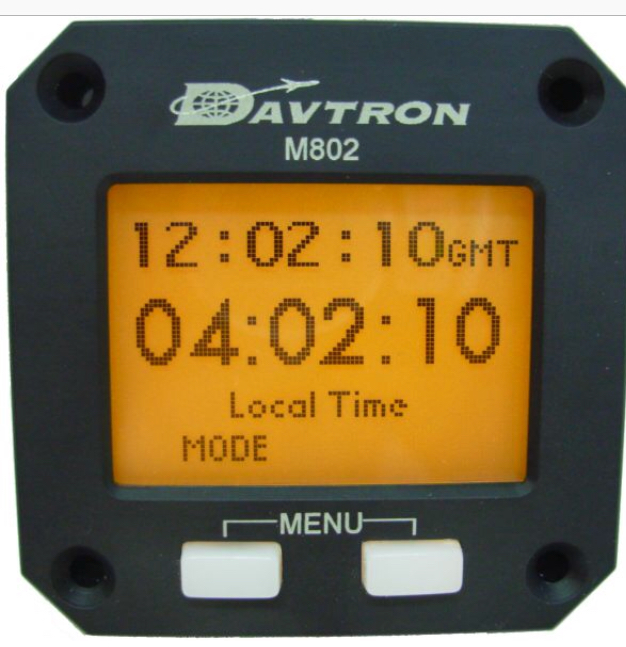

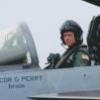
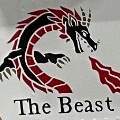


.thumb.png.7c67574d7b28f67b0b4a17760919b1ac.png)

